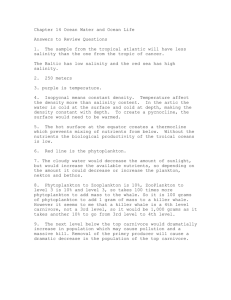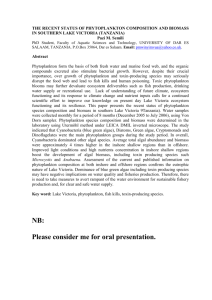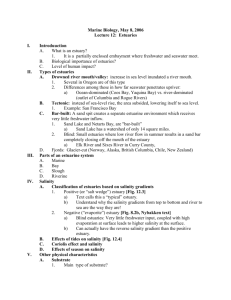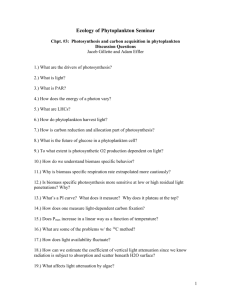Microsoft Word - Open Access Repository of Indian Theses
advertisement
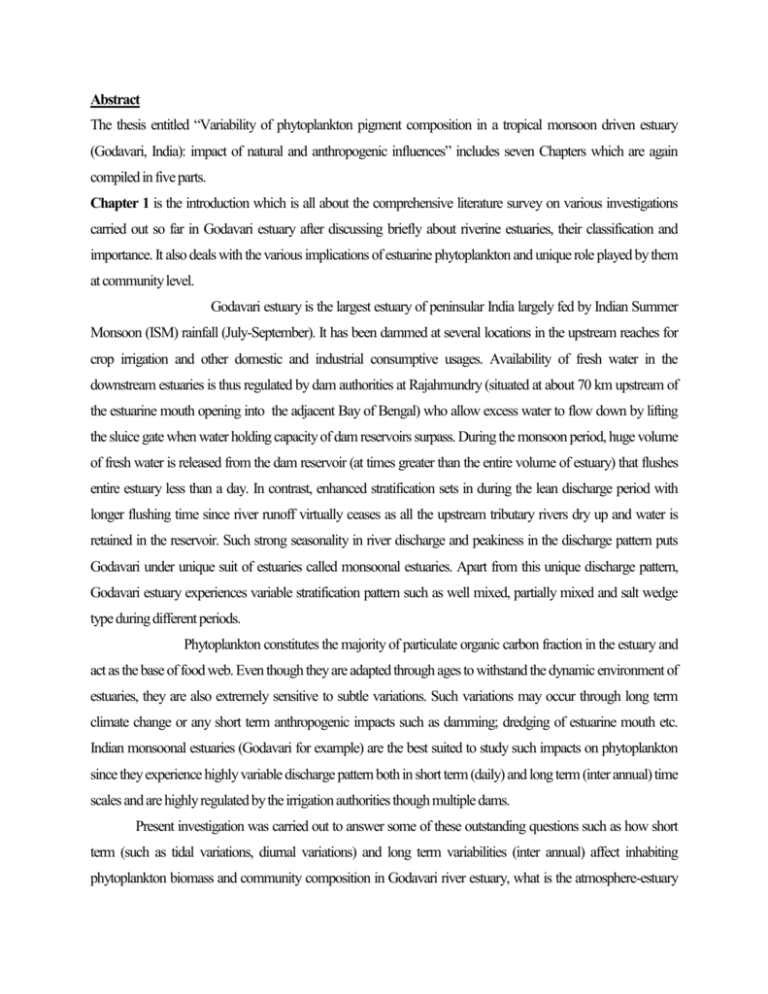
Abstract The thesis entitled “Variability of phytoplankton pigment composition in a tropical monsoon driven estuary (Godavari, India): impact of natural and anthropogenic influences” includes seven Chapters which are again compiled in five parts. Chapter 1 is the introduction which is all about the comprehensive literature survey on various investigations carried out so far in Godavari estuary after discussing briefly about riverine estuaries, their classification and importance. It also deals with the various implications of estuarine phytoplankton and unique role played by them at community level. Godavari estuary is the largest estuary of peninsular India largely fed by Indian Summer Monsoon (ISM) rainfall (July-September). It has been dammed at several locations in the upstream reaches for crop irrigation and other domestic and industrial consumptive usages. Availability of fresh water in the downstream estuaries is thus regulated by dam authorities at Rajahmundry (situated at about 70 km upstream of the estuarine mouth opening into the adjacent Bay of Bengal) who allow excess water to flow down by lifting the sluice gate when water holding capacity of dam reservoirs surpass. During the monsoon period, huge volume of fresh water is released from the dam reservoir (at times greater than the entire volume of estuary) that flushes entire estuary less than a day. In contrast, enhanced stratification sets in during the lean discharge period with longer flushing time since river runoff virtually ceases as all the upstream tributary rivers dry up and water is retained in the reservoir. Such strong seasonality in river discharge and peakiness in the discharge pattern puts Godavari under unique suit of estuaries called monsoonal estuaries. Apart from this unique discharge pattern, Godavari estuary experiences variable stratification pattern such as well mixed, partially mixed and salt wedge type during different periods. Phytoplankton constitutes the majority of particulate organic carbon fraction in the estuary and act as the base of food web. Even though they are adapted through ages to withstand the dynamic environment of estuaries, they are also extremely sensitive to subtle variations. Such variations may occur through long term climate change or any short term anthropogenic impacts such as damming; dredging of estuarine mouth etc. Indian monsoonal estuaries (Godavari for example) are the best suited to study such impacts on phytoplankton since they experience highly variable discharge pattern both in short term (daily) and long term (inter annual) time scales and are highly regulated by the irrigation authorities though multiple dams. Present investigation was carried out to answer some of these outstanding questions such as how short term (such as tidal variations, diurnal variations) and long term variabilities (inter annual) affect inhabiting phytoplankton biomass and community composition in Godavari river estuary, what is the atmosphere-estuary coupling in regulating phytoplankton in Godavari, how transient salinity variations shape phytoplankton community, how and why trace metals play dual role ( nutrient vs. toxicant) in the group level and community level of phytoplankton. This investigation, to the best knowledge of the author, is the first ever attempt to understand natural and anthropogenic variabilities of phytoplankton community composition through fast and robust HPLC pigment analysis approach in Indian estuaries. Above all this study was designed and conducted in an integrated approach so that phytoplankton variability could be explained in terms of physics, chemistry, meteorology, geology etc. Chapter 2 comprise with Materials and methods adopted in the study. Physiography, station locations, sampling strategies and brief methodologies of all the analytical and sensor-based measurements have been outlined in this Chapter. Since this thesis majorly concentrates on HPLC pigment analysis, it has been described in detail. An inter-calibration exercise of Chlorophyll a measurements with different instruments has also been incorporated in this Chapter. Chapter 3 compiles the discussion on Study area and hydrography. It starts with the importance of Godavari River and its estuary from biogeochemical and socio-economic point of view. In depth discussion has also been made on hydrography (temperature, salinity, total suspended matter etc.) and meteorology (atmospheric temperature, rainfall, relative humidity, wind speed and direction etc.) at the daily sampling location, Yanam. Chapter 4 Tidal Variation: Chapter 4 is all about the variability of different parameters during two tidal cycles; one in February (non-monsoon month) and the other in June (monsoon month) in the year 2010. This study shows how tidal variability of phytoplankton biomass and communities are controlled by tidal currents and their axial distribution along the estuarine channel.Godavari estuary is a micro tidal estuary (tide range from 0.5 to 1.8 m) with semi-diurnal cyclicity; i.e. it experiences two high tides and two low tides in a day. Temperature followed diurnal pattern with higher temperature during the day time and lower temperature during the night and showed no variability with tides. Estuary was more stratified with respect to salinity during the moderate discharge period (June) compared to the dry period (February). Salinity followed tidal rhythm closely. All the nutrients significantly increased during the ebb period which was consistent feature during both wet and dry periods. Phytoplankton biomass, in terms of chlorophyll a (Chl a), increased during the ebb period showing that upstream pool of phytoplankton advects down the estuary along with the tidal current. Diatom and cyanobacteria were more prevalent during the dry and wet period respectively and followed similar tidal pattern as that of the Chl a. Chapter 5 is the compilation of a long term daily observation (2007 - 2009) of phytoplankton biomass and community composition at daily sampling location in Godavari. Major emphasis has been laid on how different parameters like river discharge, salinity, nutrients, flushing time which varies in annual and inter-annual time scale regulate the quantity of biomass and composition of phytoplankton in Godavari estuary. It was found that significant amount of nutrients (>80 µM of dissolved inorganic nitrogen (DIN) and >12 µM of dissolved inorganic phosphate (DIP)) were associated with high river discharge in the Godavari estuary. However, during that time phytoplankton biomass remained low (<2 mg m-3) due to severe light limitation. Daily observation over three years revealed that decrease in precipitation over the Indian subcontinent from 2007 to 2009 resulted in the lowering of mean annual discharge in Godavari estuary from 748.63 m3s-1 in 2007 to 218.40 m3s-1 in 2009. The reduced water discharge slowed the flushing of the estuary from 1.2 days to 6.3 days, respectively. The consequent increase in stability of water column and reduced suspended material load gave rise to intense phytoplankton blooms (Chla 18 μg l-1 in 2007 to 28 μg l-1 in 2009). This study suggested that reduced river discharge creates conducive conditions for phytoplankton to bloom through enhanced stratification and reduced flushing rates. Chapter 6 was based on the laboratory based bottle experiment to understand the response of phytoplankton communities due to the transient salinity changes by natural (such as fresh water runoff) or various anthropogenic perturbations. Subtle changes in salinity of the freshwater by one practical salinity unit (PSU) completely removed green algae from the system and allowed the cyanobacteria to come into dominance. The cyanobacteria were found to tolerate higher osmotic stress until the salinity reaches to 16. The higher salinity tolerance range of the cyanobacteria was attributed to the enhanced synthesis of Zeaxanthin as protective xanthophylls against the osmotic stress. The energy cost associated with the Zeaxanthin synthesis is probably balanced by the adaptability of cyanobacteria to tolerate a wider range of salinity fluctuation which helps them to occupy the niche left by the green algae (green algae disappeared from the system at the salinity of 1). However the increase in zeaxanthin (cyanobacteria) concentration, to combat the progressively higher salinity stress, is not indefinite and after a certain salinity maxima (16 PSU, in this study) the population cannot tolerate the stress and they crash. Therefore modification of salinity in the estuary through dredging and channelling the freshwater flow would bring significant impact on ecosystem structure in the monsoonal estuaries. Chapter 7 describes another bottle experiment where stress and toxicity of different trace metals Trace metals (Copper-Cu, Zinc-Zn, Nickel-Ni and Cobalt-Co) were investigated on phytoplankton biomass and community composition at the head estuary. Trace metals are micronutrients which are typically occur at concentrations less than1ppb (parts per billion). They are indispensable as integral cofactors for a range of important enzymes essential for various cellular machineries. However, these metals may turn highly toxic above their threshold levels. Bioavailability of metals play a prominent role as this property determines what fraction of the metal would be available to be utilised as nutrient or to act as a toxicant. Trace metals are delivered into the estuary mostly via land run-off. We conducted a laboratory based incubation experiment to understand how four biologically important trace metals (Co, Ni, Cu and Zn) impart stress and toxicity on natural phytoplankton assemblage inhabiting in the estuarine head. It is evident from the data that all metals acted as a nutrient when 1 x 10-7 M of metals was exposed into the system. The variation in biomass in the freshwater system under exposure to different metals at concentrations of 1 x 10-7 M indicates that they follow the following order as a nutrient. Cu > Co > Ni > Zn. This order clearly shows that Cu acted as a nutrient and helped to increase the biomass followed by Co, Ni and Zn. The variation in biomass in the freshwater system under exposure to different metals at concentrations of 1 x 10-6 M indicates that they follow the following order as toxicant. Cu > Co > Zn > Ni In general it is found that phytoplankton communities in Godavari River station have different tolerance for different metals. Cu and Zn were found to be lethal at high concentration. Cyanobacteria were found to be very sensitive to slight variation in Ni concentration and Co was found to be less toxic than Cu but more toxic than Zn at high exposed concentration. Estuary receives variable metal pollution at different locations and different phytoplankton groups have variable threshold levels to withstand. Once the level of the metal concentration crosses its limits, it would have lethal effect on phytoplankton and shift in community structure is inevitable that would have significant impact not only in the primary but propagate to secondary and tertiary producers. Estuaries are extremely important in processing the in-situ and land driven materials to the adjacent coastal ocean and phytoplankton play pivotal role in the entire process. Present investigation showed that monsoonal estuaries such as Godavari are extremely sensitive towards fresh water availability since fresh water brings nutrients; both macro and micronutrients such as trace metals, churn out sediments, modify salinity, alter flushing and residence time of the water parcel and all these factors directly or indirectly control phytoplankton biomass and community composition. Since phytoplankton constitute the base of the food chain and zooplankton exhibit strong feeding preference, any change in the phytoplankton biomass and community composition could detrimentally affect other higher trophic levels ( fish for example) in the estuary and thus humans on land. Evidences are also piling up that fresh water delivered by all the east coast estuaries control the unique biogeochemical setting of the Bay of Bengal which in turn regulates formation of depression/cyclones that drives rainfall in the entire east coast of India. On the river Godavari, construction of several dams is underway and more have been proposed by the Indian Government. In addition to this climate change is also going to bring significant modification in the precipitation pattern over Indian subcontinent. The east coast estuaries (including Godavari) are linked with the Bay as well as with the atmosphere via fresh water supply in a complex feedback loop. Any jeopardy in this fine loop, either natural or manmade, would bring irreversible changes in these sensitive ecosystems.

